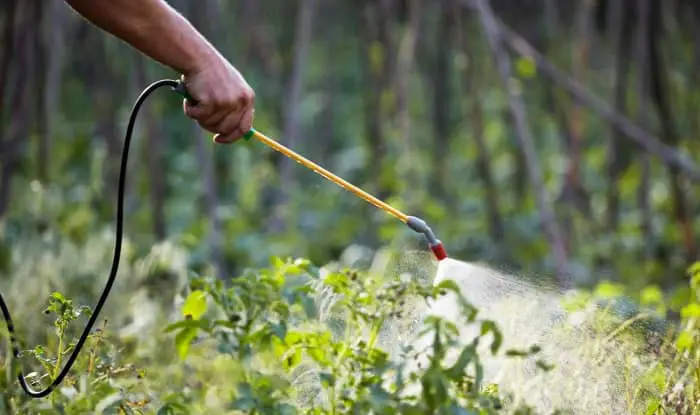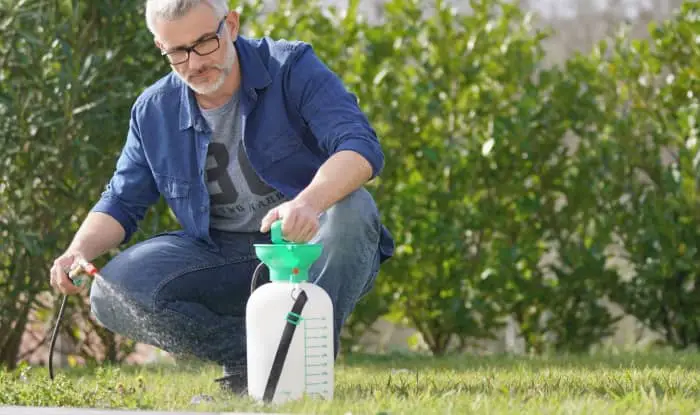You can apply pre-emergent and post-emergent herbicides at the same time. The post-emergent will kill any weeds that are growing above ground. And the pre-emergent prevents weed seeds from sprouting in your yard.
But the best time to apply pre-emergent herbicides is often not the best time to apply post-emergent herbicides. So you may need more applications of post-emergent to control weeds throughout the growing season.
But with the right expectations you can get good results using the two herbicides together correctly.
So in this article, I’ll tell you the pros and cons of using pre-emergent and post-emergent at the same time. And the things you need to know to use them together for weed control.
Let’s dive in.
How Do Pre-emergent And Post-emergent Herbicides Work?
Pre-emergent and post-emergent herbicides kill weeds in different stages of their life-cycle. And combining the use of post-emergents and pre-emergents is one of the most effective ways to keep your yard weed-free.
Pre-emergent and post-emergent herbicides work in different ways that affect how you use them:
Pre-emergent Herbicides
The best time to apply pre-emergent herbicides is shortly before weed seeds germinate. This prevents the weeds from developing into plants.
You can use pre-emergent herbicides to control summer-annual weeds and winter-annual weeds. But they don’t have much effect on perennial weeds.
To control summer-annual weeds such as crabgrass, you should apply the pre-emergent to the ground a couple of weeks before the weed seeds germinate. The best time to apply pre-emergent herbicide is in the early spring when the soil reaches 55°F for several days.
To control winter-annual weeds like Poa annua, henbit, and chickweed, it’s best to apply the pre-emergent herbicide somewhere around late summer to early fall. Wait until the soil temperature drops to 70°F.
Pre-emergent herbicide works by creating a chemical barrier in the soil. When the weed seeds germinate, the developing roots and shoots come into contact with the herbicide. The chemicals prevent cell division and enzyme function and cause the weed seedling to die before it emerges through the topsoil.
Post-emergent Herbicides
You can use post-emergent herbicides to control weeds that are growing above ground. Depending on the herbicide, you can kill annual broadleaf weeds and grassy weeds, as well as perennial weeds.
Post-emergent herbicides come in different types, contact herbicides, and systemic herbicides.
Contact herbicides start to kill weeds as soon as you spray them. But because they don’t kill the roots, the weeds sometimes regrow. And you will need to repeat the treatment.
Systemic herbicides kill weeds from the inside. The foliage absorbs the herbicide and translocates it through the plant to the roots. Because systemic herbicides kill the weed roots, they can stop the weed from regrowing. But some stubborn weeds may need more than one application.
Post-emergent herbicides don’t prevent weed seeds from germinating and developing.
Can You Apply Pre-emergent And Post-emergent At The Same Time?
Applying pre-emergent and post-emergent herbicides together has the benefit of saving you time and effort.
As long as you apply the pre-emergent at the right time of year, it will be effective at preventing most weeds from developing. Mixing post-emergent in the same tank will kill any weeds already growing in your yard.
For example, when you apply your pre-emergent in early spring to prevent summer-annual weeds, including a post-emergent will also kill winter-annual weeds growing in the treated area, which might prevent them from spreading seeds.
And for the control of some weed species, you sometimes have to apply the pre-emergent again a couple of months after the first application. At this point, adding a post-emergent will also kill any weeds that have managed to sprout.
But there is a negative. The best time to apply a pre-emergent is usually not the best time for applying a post-emergent.
And depending on where you live, there might be restrictions on how often you can use some types of post-emergent herbicides. So if you use a herbicide in early spring, before summer-annual weeds are growing above ground, then the applications you can make later in the year to kill them may be limited.
Tips For Applying Pre-emergent And Post-emergent Together
You have to water pre-emergent herbicide to activate it and form a chemical barrier in the upper layers of the soil.
But watering might dilute the post-emergent and cause it to run off the weeds. And post-emergent herbicide needs time on the plant to work.
Because of this, it’s good to wait 24 hours before watering the pre-emergent and post-emergent mixture. But some post-emergent weed killers become rainfast quicker, so check the product label.
Rather than buying a pre-emergent and a post-emergent, you can get herbicides that do both. An example of this is Tenacity. But Tenacity is not safe for all turfgrasses, so check the label to make sure it’s safe to use on your lawn.
Wait a few days after mowing before applying the mixture. Weeds absorb post-emergent through the leaves. So the more surface area available the better the results. Also, wait a few days after spraying before you mow again to give systemic weed killers a chance to work.


